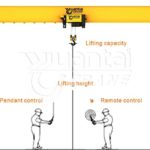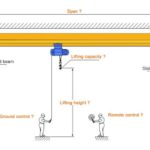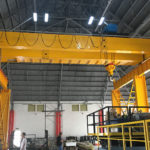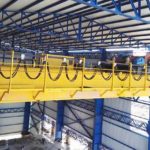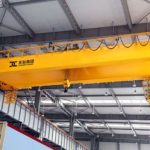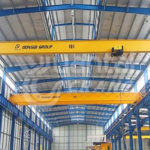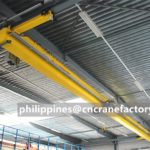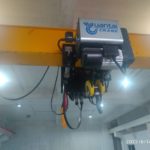Purchasing an overhead crane system is a long-term investment that can dramatically improve operations, streamline production, and increase worker safety. Selecting the best system for your application and facility will ultimately save you money in the future. However, choosing the right crane can be overwhelming and confusing. There are a lot of factors to consider, but we can make that process a little easier by providing critical information that will help you to make the right choice—and the best possible investment.
It’s important to consider what types of overhead cranes are available and become familiar with them. There are four main types of overhead cranes: gantry cranes, monorail cranes, workstation bridge cranes, and jib cranes. Knowing what each type of crane does and how it is designed will help you to select the right system for your application. Check out our Products page for additional information about each type of crane, or contact us to request a brochure or to speak with a material handling expert.
Once you have a general understanding about the different overhead cranes available, there are two major categories that will help you to select the right crane for your operation: application and facility. Each category includes a set of factors, which are broken down to provide a basic overview that will help you to select a crane.
Analyze Your Application
Starting with an honest evaluation of your material handling needs is a fundamental part of selecting the right system. Choosing a crane that is inappropriate for your application could be a dangerous, inefficient, and costly mistake. Consider the needs of your specific application and what you would like to achieve by integrating a new overhead lift system into your facility.
To help you develop a detailed analysis of your application and material handling needs, we have broken down the application category into five parts: capacity and service rating, structural components, mechanical and electrical components, motor controls, and operator controls.
1. Capacity and Service Rating
The load rating capacity is the maximum load weight a crane can handle. It’s important to note the load capacity and frequency of operation. Operating a crane above its load rating capacity is extremely dangerous and can cause serious damage to your new system. Be sure that the maximum weight requirements of your application are less than the load rating capacity of the crane. Knowing this information will also help you to identify the right service rating classification for your new crane.
2. Structural Components
Most overhead cranes are made from welded steel plates or aluminum sections. The more steel, the heavier the crane. Consider your service classification and compare it to the type of crane you are interested in purchasing. Gantry Cranes, for example, can either be steel or aluminum. Whereas aluminum gantry cranes are designed for lightweight applications and total portability, a steel gantry crane will provide a higher load rated capacity and is designed for heavier applications. Understanding these options will help you to make the best choice for your operation and control some of the structural elements that impact the weight of the crane and its cost.
3. Mechanical & Electrical Components
Overhead cranes in general provide a variety of options beyond design and structure. Choosing the best mechanical and electrical options can be a daunting task without the right approach. But, if you consider the needs of your application and facility first, you can eliminate some of that confusion. There are multiple mechanical and electrical component options for each type of overhead crane we manufacture. Knowing what each component does and how it will impact your particular application will help you to decide which options are necessary.
In some instances, you might find that your application requires something that just doesn’t work in your facility. For instance, a telescoping bridge crane is a viable option for applications that require extended reach, especially when there are a lot of obstructions in or around your work area. The telescoping bridge travels beneath the bridge track, providing a larger scope of reach and the ability to move beyond a support column or under a mezzanine.
If your operation requires a system that can easily transport materials from one work area to another, you can leverage your system’s flexibility by using a mixed capacity bridge crane. Using heavier capacity runways with multiple smaller capacity bridges increases your coverage and provides a more versatile system. Depending on your application, adding or altering mechanical components can mean the difference between the wrong system and a highly effective system. Defining the needs and limitations of your application and facility will give you the opportunity to choose a system with the right components.
Depending on your operation, electrical components may also contribute to the overall efficiency of your new crane system. For applications and facilities that require workers to move materials in and out of hard-to-reach areas and around obstacles, adding a tractor drive to motorize the bridge or hoist trolley is extremely helpful. If your application requires workers to lift and transport heavy machinery, you can motorize the rotation of your jib boom for ease of use and increased efficiency. For assembly applications that require workers to move materials along a fixed path, an electric track-mounted gantry may be the best solution. Track mounting ensures that the crane moves along its fixed route, and adding the electrical component provides motorized travel for ease of use and increased productivity. Take the time to discuss key components with your supplier to decide which electrical components, if any, are suited for your application.

4. Motor Controls & Operator Controls
Another important option to consider when choosing the right system for your operation is the use of motor controls. Electrical control systems allow you to manipulate bridge and trolley motions for increased precision and safe, controlled lifting. These components also impact the cost of the crane, so making the best choice for your operation is crucial. If you choose to purchase a motorized system, ask your supplier if they provide speed control. A variable frequency drive, for instance, is an adjustable-speed drive used to control motor speed and torque by varying motor input frequency and voltage.
For more information about overhead crane standards, regulations, and guidelines, contact us.
